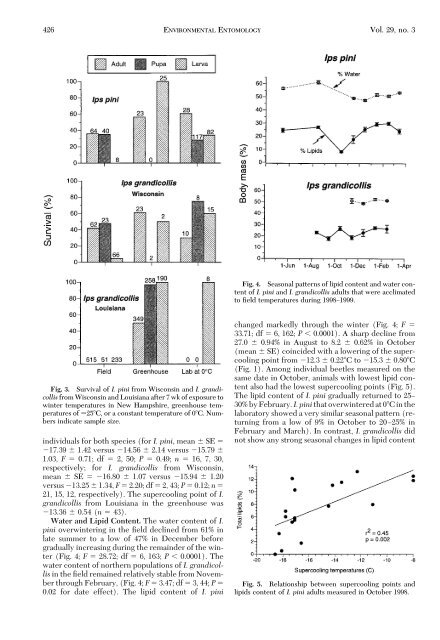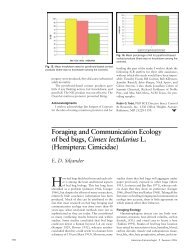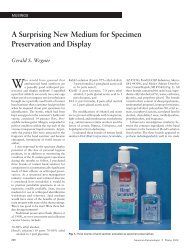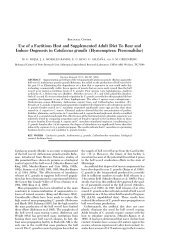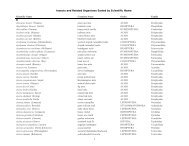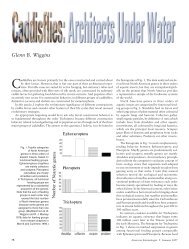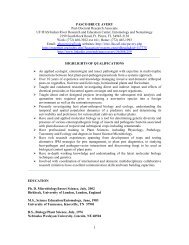Cold Tolerance of Four Species of Bark Beetle (Coleoptera ...
Cold Tolerance of Four Species of Bark Beetle (Coleoptera ...
Cold Tolerance of Four Species of Bark Beetle (Coleoptera ...
You also want an ePaper? Increase the reach of your titles
YUMPU automatically turns print PDFs into web optimized ePapers that Google loves.
426 ENVIRONMENTAL ENTOMOLOGY Vol. 29, no. 3<br />
Fig. 3. Survival <strong>of</strong> I. pini from Wisconsin and I. grandicollis<br />
from Wisconsin and Louisiana after 7 wk <strong>of</strong> exposure to<br />
winter temperatures in New Hampshire, greenhouse temperatures<br />
<strong>of</strong> 25C, or a constant temperature <strong>of</strong> 0C. Numbers<br />
indicate sample size.<br />
individuals for both species (for I. pini, mean SE <br />
17.39 1.42 versus 14.56 2.14 versus 15.79 <br />
1.03, F 0.71; df 2, 50; P 0.49; n 16, 7, 30,<br />
respectively; for I. grandicollis from Wisconsin,<br />
mean SE 16.80 1.07 versus 15.94 1.20<br />
versus 13.25 1.34, F 2.20; df 2, 43; P 0.12; n <br />
21, 15, 12, respectively). The supercooling point <strong>of</strong> I.<br />
grandicollis from Louisiana in the greenhouse was<br />
13.36 0.54 (n 43).<br />
Water and Lipid Content. The water content <strong>of</strong> I.<br />
pini overwintering in the Þeld declined from 61% in<br />
late summer to a low <strong>of</strong> 47% in December before<br />
gradually increasing during the remainder <strong>of</strong> the winter<br />
(Fig. 4; F 28.72; df 6, 163; P 0.0001). The<br />
water content <strong>of</strong> northern populations <strong>of</strong> I. grandicollis<br />
in the Þeld remained relatively stable from November<br />
through February, (Fig. 4; F 3.47; df 3, 44; P <br />
0.02 for date effect). The lipid content <strong>of</strong> I. pini<br />
Fig. 4. Seasonal patterns <strong>of</strong> lipid content and water content<br />
<strong>of</strong> I. pini and I. grandicollis adults that were acclimated<br />
to Þeld temperatures during 1998Ð1999.<br />
changed markedly through the winter (Fig. 4; F <br />
33.71; df 6, 162; P 0.0001). A sharp decline from<br />
27.0 0.94% in August to 8.2 0.62% in October<br />
(mean SE) coincided with a lowering <strong>of</strong> the supercooling<br />
point from 12.3 0.22Cto15.3 0.80C<br />
(Fig. 1). Among individual beetles measured on the<br />
same date in October, animals with lowest lipid content<br />
also had the lowest supercooling points (Fig. 5).<br />
The lipid content <strong>of</strong> I. pini gradually returned to 25Ð<br />
30% by February. I. pini that overwintered at 0Cinthe<br />
laboratory showed a very similar seasonal pattern (returning<br />
from a low <strong>of</strong> 9% in October to 20Ð25% in<br />
February and March). In contrast, I. grandicollis did<br />
not show any strong seasonal changes in lipid content<br />
Fig. 5. Relationship between supercooling points and<br />
lipids content <strong>of</strong> I. pini adults measured in October 1998.


